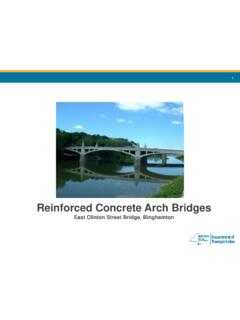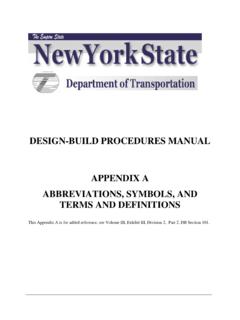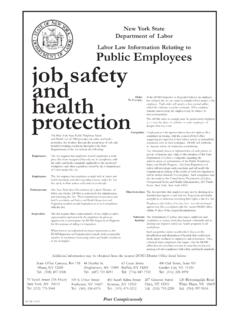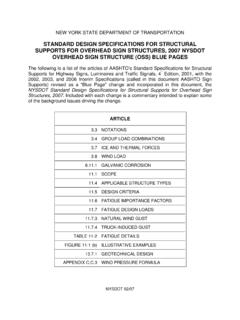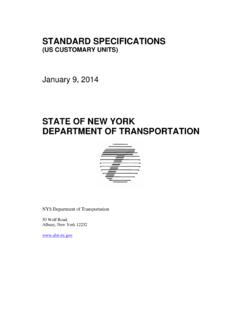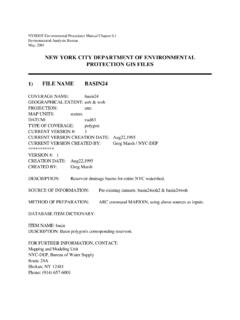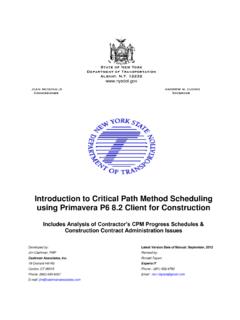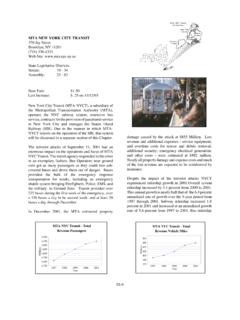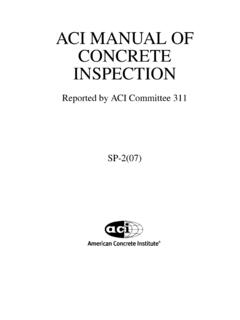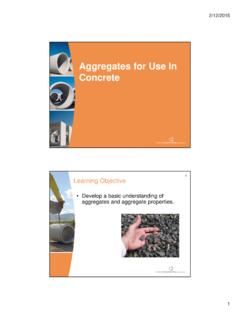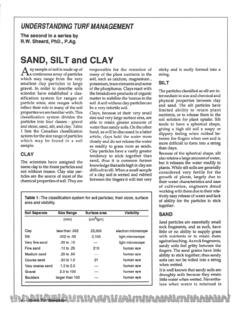Transcription of SUBJECT: HOT MIX ASPHALT (HMA) MIXTURE DESIGN AND …
1 I MATERIALS BUREAU ALBANY, NY 12232-0861 Materials Method: MM Issue Date: January 2019 Subject Code: MATERIALS METHOD SUBJECT: HOT MIX ASPHALT (HMA) MIXTURE DESIGN AND MIXTURE VERIFICATION PROCEDURES APPROVED: /s/ John E. Rondinaro John E. Rondinaro, , Director, Materials Bureau Supersedes: MM Dated: August 2012 PREFACE Materials Method describes New York State Department of Transportation s (NYSDOT) requirements and policies for the development of Hot Mix ASPHALT (HMA) MIXTURE designs, including the responsibilities of the Producer and the Department. This Materials Method (MM) also gives the specific testing details and evaluation procedures to be followed in the HMA MIXTURE DESIGN process. Conformance with MM assures uniform testing and evaluation of paving mixtures through volumetric analysis of laboratory and plant prepared specimens.
2 The purpose of the HMA MIXTURE DESIGN system is to DESIGN HMA mixtures that achieve the fundamental volumetric properties needed to result in maximum pavement performance. It is extremely important that the plant quality control procedures outlined in the Producer s Quality Control Plan are followed to ensure uniform production. Department personnel may suggest to a Producer the methods for improving a MIXTURE DESIGN , with the understanding that the suggestions do not bind NYSDOT to accepting material outside of specifications. Note: This Materials Method (MM) may require the use of hazardous materials and safety sensitive procedures. This MM does not address any of the safety problems associated with its use. It is the responsibility of the user of this MM to establish appropriate safety and health practices and determine the applicability of regulatory limitations prior to use.
3 Materials Method ii TABLE OF CONTENTS PREFACE .. i I. SCOPE .. 1 II. GENERAL .. 1 III. INFORMATION SOURCES .. 1 IV. DETAILS OF RESPONSIBILITY .. 4 A.. 4 1. Analysis of Plant aggregate Gradation .. 4 2. Establishing and Maintaining RAP Stockpiles .. 4 3. Obtaining aggregate and RAP Samples .. 4 4. Job Mix Formula (JMF) Development .. 4 5. Data Documentation .. 5 6. HMA DESIGN Submission .. 5 7. Production Notification .. 5 8. Production Monitoring - Quality Control .. 5 B. NYSDOT .. 5 1. HMA DESIGN Review .. 5 2. Production Monitoring - Quality Assurance .. 6 V. DESIGN PROCEDURE .. 6 A. Materials Selection .. 6 1. aggregate Selection/Requirements .. 6 2. Performance-Graded Binder Selection .. 7 3. Warm Mix ASPHALT Technology Selection .. 7 B. DESIGN aggregate Structure Selection .. 8 1. MIXTURE aggregate Consensus Properties .. 8 2. Friction aggregate Requirements..10 3. Estimating DESIGN Binder Content.
4 11 C. DESIGN PG Binder Content Selection ..11 1. Selecting PG Binder Contents for Evaluation ..11 2. Data Analysis and Curve Preparation ..12 3. DESIGN Performance-Graded Binder Content Selection ..12 D. Warm Mix ASPHALT Technology ..13 E. Moisture Susceptibility Testing ..14 1. Criteria for Use ..14 2. Procedure ..14 Materials Method iii VI. SPECIMEN FORMULATION ..14 A. Plant aggregate Gradation Analysis ..15 1. Batch Plants ..15 2. Drum Mix Plants ..16 B. aggregate Preparation ..16 C. Specimen Batching and 1. Batching ..18 2. Compaction ..20 VII. RECYCLED HOT MIX ASPHALT DESIGN PROCEDURE ..20 A. Materials Selection ..21 1. aggregate Selection ..21 2. Performance-Graded Binder Selection ..21 B. RAP Properties Determination..21 1. Obtaining RAP Samples ..21 2. RAP Binder Content Determination ..22 C. DESIGN aggregate Structure Selection..22 1. Recycled MIXTURE aggregate Consensus Properties.
5 22 2. Recycled MIXTURE Friction aggregate 22 3. Estimating Total DESIGN Binder D. DESIGN Total Binder Content Selection ..23 1. Selecting Total Binder Contents for Evaluation ..23 2. Data Analysis and Curve Preparation ..24 3. DESIGN Total Binder Content Selection ..24 E. Warm Mix ASPHALT Technology DESIGN ..24 F. Moisture Susceptibility Testing ..24 VIII. RECYCLED HOT MIX ASPHALT SPECIMEN FORMULATION ..24 A. Plant aggregate Gradation and RAP Binder Content Analysis ..25 B. aggregate and RAP Preparation ..25 C. Specimens Batching and Compaction ..25 IX. VERIFICATION ..26 A . MIXTURE DESIGN Review ..26 B .Laboratory Verification ..27 C. Plant Verification ..28 1. Initial Production Notification ..28 2. Supplying Verification Status Material to Department Projects ..28 3. Quality Control During Verification Status Production ..28 4. Determining QAFs for Verification Status Material ..29 5. Assigning Production Status.
6 29 D. Warm Mix ASPHALT Technology 30 Materials Method iv APPENDICES VOLUMETRIC ANALYSIS OF RAW MATERIALS AND SUPERPAVE SPECIMENS ..Appendix 1 - 1 LABORATORY EQUIPMENT LIST ..Appendix 2 - 1 SUPERPAVE DEFINITION OF TERMS AND ABBREVIATIONS ..Appendix 3 - 1 LIST OF TABLES Table 1 - DESIGN Control Points .. 8 Table 2 - Additional aggregate Criteria .. 9 Table 3 - PG Binder Content Table 4 - DESIGN Criteria ..13 Table 5 - Volumetric DESIGN Criteria ..13 Table 6 - aggregate Size Fractions ..17 Table 7 - Mixing and Compaction Table 8 - Scale Requirements ..19 Table 9 - DESIGN Number of Gyrations ..20 Table 10 - PG Binder Content DESIGN (>10% RAP)..23 Table 11 - Laboratory Verification Tolerances ..27 Table 12 - Laboratory to Laboratory Verification NYSDOT Materials Method 1 I. SCOPE This Materials Method (MM) describes the responsibilities and procedures for the development and review of hot mix ASPHALT (HMA) MIXTURE designs.
7 This MM outlines a complete procedure for the uniform DESIGN of volumetric mixtures for Top Course HMA, Top Course HMA, Top Course HMA, Binder Course HMA, Binder Course HMA, or Base Course HMA. II. GENERAL The MIXTURE DESIGN system is based on the Superpave DESIGN system and Performance-Graded (PG) binder specification developed through research performed during the Strategic Highway Research Program (SHRP). The Superpave system was developed to address three principal distresses that plague HMA pavement: rutting, fatigue cracking, and low temperature cracking. The objective of the HMA mix DESIGN system is to define an economical blend of PG binder and aggregate yielding a paving MIXTURE having sufficient air voids, voids in the mineral aggregate (VMA) and voids filled with binder (VFB) that will perform satisfactorily over the pavement s service life.
8 The MIXTURE and binder requirements are tailored to accommodate the diverse, but specific, climate and traffic conditions that pavements are exposed to at projects sites across the State. The HMA MIXTURE DESIGN procedure is used to establish proper proportions of aggregates, reclaimed ASPHALT pavement (when applicable), and PG binder to meet the required MIXTURE volumetric properties, given the specific traffic and weather conditions of the project location. Reclaimed ASPHALT pavement (RAP) may be used in the DESIGN and production of any HMA MIXTURE . The Producer is responsible for preparing the HMA DESIGN ; NYSDOT is responsible for checking the submitted MIXTURE DESIGN for completeness and accuracy. The Regional Director or his representative has final acceptance authority. A complete HMA MIXTURE DESIGN is required for each aggregate source combination, differing aggregate gradations, differing RAP percentages, and a separate job mix formula (JMF) for each plant using the same aggregate at a site having multiple plants.
9 When a Warm Mix ASPHALT (WMA) technology is utilized for the production of ASPHALT mixtures, the Producer shall comply with the technology s current Production, Testing, and Compaction Details from the Department s Approved List. The Producer must become familiar with these Details and adhere to their requirements. When the WMA technology is pre-blended with the PG binder, the dosage shall be as recommended by the technology supplier. III. INFORMATION SOURCES The following is a list of the various sources of information that must be consulted, in addition to this MM, to prepare an HMA MIXTURE DESIGN . Use the most current version of each of the information sources listed, particularly any AASHTO Provisional Standard that may be reissued as an AASHTO Standard Specification. 1. NYSDOT Standard Specifications - including all Addenda and the Project NYSDOT Materials Method 2 Proposal.
10 2. NYSDOT Approved List, Sources of fine & coarse Aggregates. 3. AASHTO R 90 Standard Practice for Sampling aggregate Products 4. NYDOT Approved List Materials & Equipment 5. NYSDOT Materials Method 28 - Friction aggregate Control and Test Procedures. 6. NYSDOT Materials Procedure 401 - Quality Control and Quality Assurance Procedures for Hot Mix ASPHALT (HMA) Production. 7. NYSDOT Technical Report 01-02 - Using Reclaimed ASPHALT Pavement in Superpave Hot Mix ASPHALT . 8. AASHTO M 231 Standard Specification for Weighing Devices Used in the Testing of Materials. 9. AASHTO M 332 Standard Specification for Performance-Graded ASPHALT Binder Using Multiple Stress Creep Recovery (MSCR) Test. 10. AASHTO M 323 Standard Specification for Superpave Volumetric Mix DESIGN . 11. AASHTO R 30 Standard Practice for MIXTURE Conditioning of Hot Mix ASPHALT (HMA). 12. AASHTO R 35 Standard Practice for Superpave Volumetric DESIGN for ASPHALT Mixtures.
